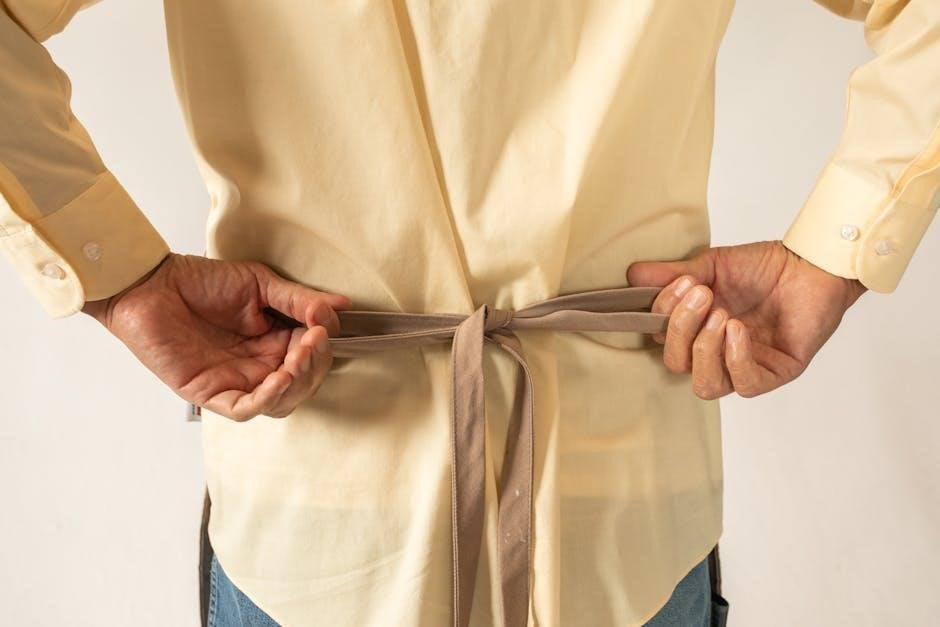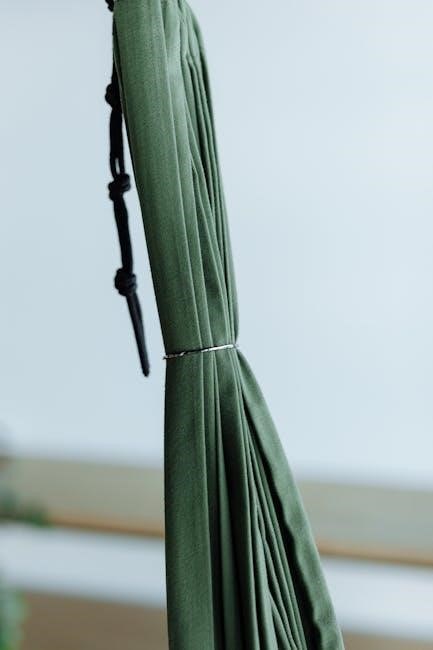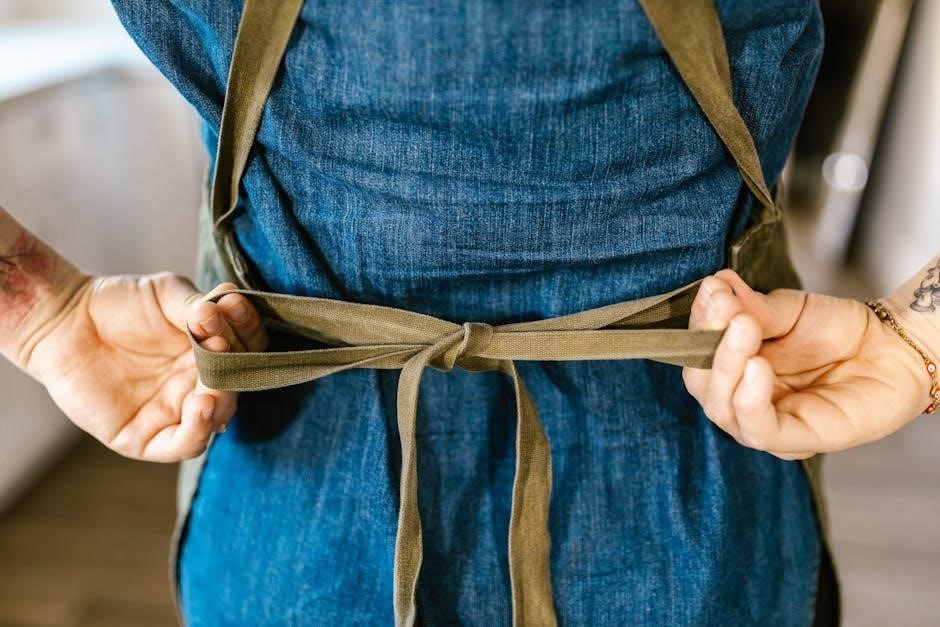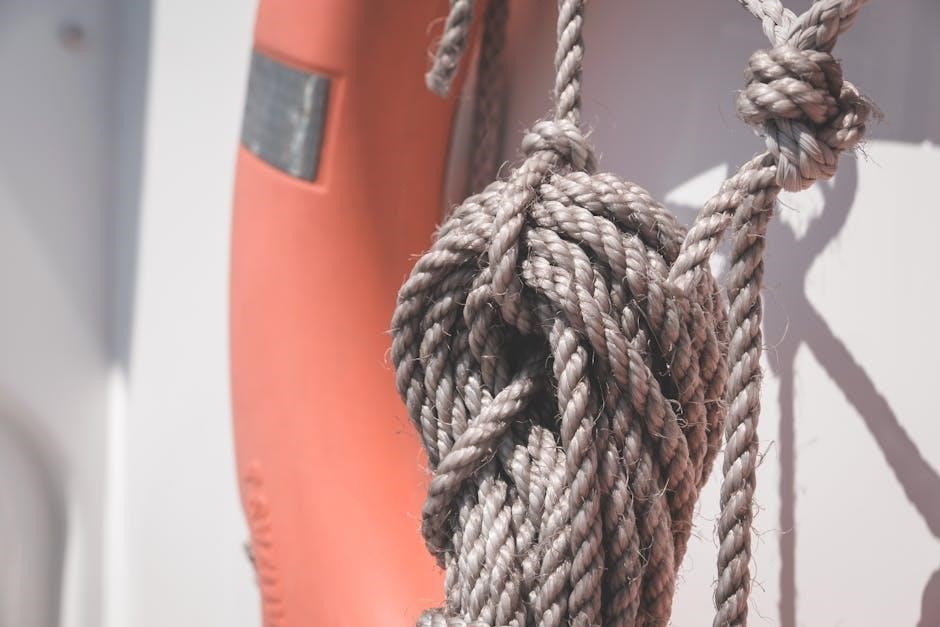The knot tying guide pdf provides essential information on various knots, including the Palomar and Bowline, with step-by-step instructions and diagrams to help users master the art of knot tying quickly and easily always.
Overview of the Guide
The knot tying guide pdf is a comprehensive resource that covers the fundamentals of knot tying, including the different types of knots, their applications, and step-by-step instructions on how to tie them. The guide is designed to be user-friendly, making it easy for beginners to learn and master the art of knot tying. The guide includes detailed diagrams and illustrations to help users understand the different knots and how to tie them correctly. The guide also covers the importance of knot tying in various industries, such as sailing, climbing, and rescue operations. With the knot tying guide pdf, users can learn how to tie knots quickly and easily, and gain a deeper understanding of the different types of knots and their applications. The guide is a valuable resource for anyone looking to improve their knot tying skills, and is suitable for both beginners and experienced knot tiers. The guide is available for download, making it easily accessible to anyone with an internet connection.

Types of Knots
Various knots exist, including stopper, loop, and bend knots, each serving specific purposes and applications always using different techniques.
Palomar Knot
The Palomar Knot is a popular choice among anglers due to its strength and reliability. It is often used to attach lures or hooks to the end of a fishing line. The Palomar Knot is considered one of the strongest knots, with a high rating of 95%. It is also relatively easy to tie, making it a great option for those new to knot tying. To tie a Palomar Knot, start by doubling the line and passing it through the eye of the hook. Then, tie an overhand knot and pass the loop over the standing line. Finally, pull the knot tight and trim the excess line. The Palomar Knot is a great all-around knot that can be used in a variety of fishing situations. Its strength and reliability make it a popular choice among anglers, and its ease of use makes it a great option for those just starting out. The Palomar Knot is an essential knot to know for any angler.

Knot Tying Techniques
Mastering various knot tying techniques requires practice and patience to ensure secure and reliable knots always using proper methods and tools available online.
Bowline Knot
The Bowline knot is a fundamental knot in the world of knot tying, and it is essential to learn how to tie it properly.
It is used to create a fixed loop at the end of a rope, and it is commonly used in sailing, rock climbing, and rescue operations.
The Bowline knot is also known as the king of knots, and it is a crucial part of any knot tying guide.
To tie a Bowline knot, you need to start by holding the rope in your non-dominant hand, with the end of the rope facing away from you.
Then, you need to use your dominant hand to create a loop in the rope, and pass the end of the rope through the loop.
Next, you need to take the end of the rope and pass it under the standing part of the rope, and then bring it back up through the loop.
Finally, you need to pull the end of the rope gently to tighten the knot, and adjust it as needed to make sure it is secure.
The Bowline knot is a reliable and trustworthy knot that can be used in a variety of situations.
It is easy to learn and remember, and it is an essential part of any knot tying guide or tutorial.
With practice and patience, anyone can master the Bowline knot and use it to create secure and reliable loops in a rope.
The Bowline knot is a valuable skill to have, and it can be used in many different contexts.
It is a fundamental part of knot tying, and it is an essential knot to learn for anyone who wants to become proficient in knot tying.
The Bowline knot is a simple yet effective knot that can be used to create a fixed loop at the end of a rope.
It is a crucial part of any knot tying guide, and it is an essential skill to have for anyone who wants to learn how to tie knots.
The Bowline knot is easy to learn, and it can be mastered with practice and patience.
It is a reliable and trustworthy knot that can be used in a variety of situations, and it is an essential part of any knot tying tutorial or guide.
The Bowline knot is a fundamental knot that is used to create a fixed loop at the end of a rope, and it is commonly used in sailing, rock climbing, and rescue operations.
It is a crucial part of any knot tying guide, and it is an essential skill to have for anyone who wants to learn how to tie knots.
The Bowline knot is easy to learn, and it can be mastered with practice and patience.
It is a reliable and trustworthy knot that can be used in a variety of situations, and it is an essential part of any knot tying tutorial or guide.
The Bowline knot is a valuable skill to have, and it can be used in many different contexts.
It is a fundamental part of knot tying, and it is an essential knot to learn for anyone who wants to become proficient in knot tying.
The Bowline knot is a simple yet effective knot that can be used to create a fixed loop at the end of a rope, and it is commonly used in sailing, rock climbing, and rescue operations.
It is a crucial part of any knot tying guide, and it is an essential skill to have for anyone who wants to learn how to tie knots;
The Bowline knot is easy to learn, and it can be mastered with practice and patience;
It is a reliable and trustworthy knot that can be used in a variety of situations, and it is an essential part of any knot tying tutorial or guide.
The Bowline knot is a fundamental knot that is used to create a fixed loop at the end of a rope.
It is a valuable skill to have, and it can be used in many different contexts.
It is a fundamental part of knot tying, and it is an essential knot to learn for anyone who wants to become proficient in knot tying.
The Bowline knot is a simple yet effective knot that can be used to create a fixed loop at the end of a rope.
It is a crucial part of any knot tying guide, and it is an essential skill to have for anyone who wants to learn how to tie knots.
The Bowline knot is easy to learn, and it can be mastered with practice and patience.
It is a reliable and trustworthy knot that can be used in a variety of situations, and it is an essential part of any knot tying tutorial or guide.
The Bowline knot is a fundamental knot that is used to create a fixed loop at the end of a rope, and it is commonly used in sailing, rock climbing, and rescue operations.
It is a crucial part of any knot tying guide, and it is an essential skill to have for anyone who wants to learn how to tie knots.
The Bowline knot is easy to learn, and it can be mastered with practice and patience.
It is a reliable and trustworthy knot that can be used in a variety of situations, and it is an essential part of any knot tying tutorial or guide.
The Bowline knot is a valuable skill to have, and it can be used in many different contexts.
It is a fundamental part of knot tying, and it is an essential knot to learn for anyone who wants to become proficient in knot tying.
The Bowline knot is a simple yet effective knot that can be used to create a fixed loop at the end of a rope.
It is a crucial part of any knot tying guide, and it is an essential skill to have for anyone who wants to learn how to tie knots.
The Bowline knot is easy to learn, and it can be mastered with practice and patience.
It is a reliable and trustworthy knot that can be used in a variety of situations, and it is an essential part of any knot tying tutorial or guide.
The Bowline knot is a fundamental knot that is used to create a fixed loop at the end of a rope, and it is commonly used in sailing, rock climbing, and rescue operations.
It is a crucial part of any knot tying guide, and it is an essential skill to have for anyone who wants to learn how to tie knots.
The Bowline knot is easy to learn, and it can be mastered with practice and patience.
It is a reliable and trustworthy knot that can be used in a variety of situations, and it is an essential part of any knot tying tutorial or guide.
The Bowline knot is a valuable skill to have, and it can be used in many different contexts.
It is a fundamental part of knot tying, and it is an essential knot to learn for anyone who wants to become proficient in knot tying.
The Bowline knot is a simple yet effective knot that can be used to create a fixed loop at the end of a rope.
It is a crucial part of any knot tying guide, and it is an essential skill to have for anyone who wants to learn how to tie knots.
The Bowline knot is easy to learn, and it can be mastered with practice and patience.
It is a reliable and trustworthy knot that can be used in a variety of situations, and it is an essential part of any knot tying tutorial or guide.
The Bowline knot is a fundamental knot that is used to create a fixed loop at the end of a rope.
It is a valuable skill to have, and it can be used in many different contexts.
It is a fundamental part of knot tying, and it is an essential knot to learn for anyone who wants to become proficient in knot tying.
The Bowline knot is a simple yet effective knot that can be used to create a fixed loop at the end of a rope.
It is a crucial part of any knot tying guide, and it is an essential skill to have for anyone who wants to learn how to tie knots.
The Bowline knot is easy to learn, and it can be mastered with practice and patience.
It is a reliable and trustworthy knot that can be used in a variety of situations, and it is an essential part of any knot tying tutorial or guide.
The Bowline knot is a fundamental knot that is used to create a fixed loop at the end of a rope, and it is commonly used in sailing, rock climbing, and rescue operations.
It is a crucial part of any knot tying guide, and it is an essential skill to have for anyone who wants to learn how to tie knots.
The Bowline knot is easy to learn, and it can be mastered with practice and patience.
It is a reliable and trustworthy knot that can be used in a variety of situations, and it is an essential part of any knot tying tutorial or guide.
The Bowline knot is a valuable skill to have, and it can be used in many different contexts.
It is a fundamental part of knot tying, and it is an essential knot to learn for anyone who wants to become proficient in knot tying.
The Bowline knot is a simple yet effective knot that can be used to create a fixed loop at the end of a rope.
It is a crucial part of any knot tying guide, and it is an essential skill to have for anyone who wants to learn how to tie knots.
The Bowline knot is easy to learn, and it can be mastered with practice and patience.
It is a reliable and trustworthy knot that can be used in a variety of situations, and it is an essential part of any knot tying tutorial or guide.
The Bowline knot is a fundamental knot that is used to create a fixed loop at the end of a rope.
It is a valuable skill to have, and it can be used in many different contexts.
It is a fundamental part of knot tying, and it is an essential knot to learn for anyone who wants to become proficient in knot tying.
The Bowline knot is a simple yet effective knot that can be used to create a fixed

Applications of Knots

Knots are used in climbing, rescue, and other activities requiring secure rope connections and reliable knots every day always in many different situations and locations around the world somehow.
Climbing and Rescue
Knots play a crucial role in climbing and rescue operations, providing a secure and reliable means of connecting ropes, anchors, and equipment. The ability to tie knots quickly and efficiently is essential for climbers and rescuers, as it can mean the difference between a successful ascent or rescue and a potentially disastrous outcome. In climbing, knots are used to connect the rope to the climber’s harness, as well as to anchors and other equipment. In rescue situations, knots are used to create a secure and stable system for lifting and lowering people or equipment. The Bowline on a Bight is a common knot used in climbing and rescue, as it creates a non-slip loop in the middle of a line. This knot is particularly useful in situations where a quick and reliable connection is needed, such as in emergency rescues or when setting up a climbing route. With the right knots, climbers and rescuers can ensure a safe and successful outcome.
Knot tying guide pdf concludes with practical applications and encourages further learning and practice always using different techniques.
Importance of Knot Tying
The importance of knot tying cannot be overstated, as it is a crucial skill that has numerous applications in various fields, including sailing, climbing, and rescue operations. Knots are used to secure ropes, create loops, and lift heavy objects, making them an essential part of many activities. The ability to tie knots correctly is vital, as a single mistake can have serious consequences, such as equipment failure or even loss of life. Furthermore, knot tying is also an important aspect of outdoor activities, such as camping and hiking, where it can be used to create shelter, secure gear, and navigate through challenging terrain. By mastering the art of knot tying, individuals can ensure their safety and the safety of others, while also gaining a valuable skill that can be used in a variety of situations. Overall, the importance of knot tying lies in its ability to provide a secure and reliable way to manipulate ropes and other equipment.
